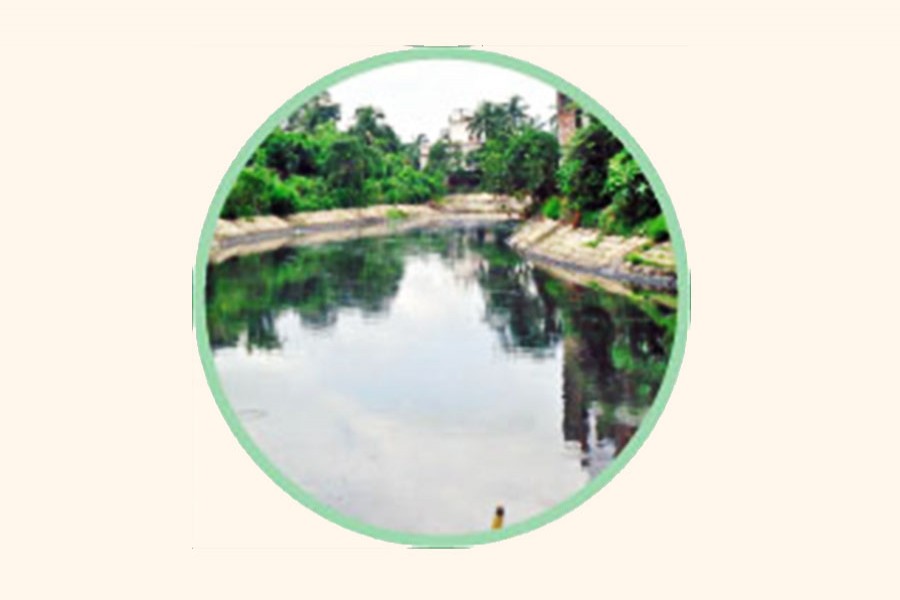Right now an eviction drive is being carried on by the Dhaka North City Corporation (DNCC) to free canals in Bosila area under Mohammadpur of unlawful occupation. It is an extensive drive and the powerful bulldozers of the corporation are knocking down illegal constructions including multi-storied buildings constructed either on occupied canal-filled land or on the banks of canals ---without mercy. In range and scope, this eviction drive is only second to the earlier one carried out by the Bangladesh Inland Water Development Authority on the banks of rivers around the city. The DNCC mayor Atiqul Islam is sure to be present there to supervise the eviction campaign, giving the impression that he means business.
Since taking over the responsibility of 26 canals from the Dhaka Water and Sewerage Authority (WASA) on December 31, 2020, the two city corporations could not make much headway in reclaiming the canals for understandable reasons. Years of indifference have allowed the problem to mount and there is also a need for managing fund for not only the eviction drive but also for excavation of the canals.
In the past such initiatives have encountered opposition from vested and powerful quarters and consequently abandoned. This time, the Local Government, Rural Development and Cooperatives (LGRDC) Minister Tajul Islam has lent his unreserved support to the canal reclamation drive. Additionally, he has unveiled a plan to connect all the canals to give the system a shape of an uninterrupted water route for movement of water transport. The minister contends that there is still the existence of 53 canals. Canals still in control of other agencies are also in the process of handing over to the city corporations. If the canals can be reclaimed and returned their near original shape for interconnection with connectivity to the four rivers girdling the city for maintaining flows of water, the city people can rest assured of its all-round benefits.
The number one benefit will accrue in the form of elimination of water-logging once and for all. The benefit can be increased many times over if dumping of solid waste and release of effluent from factories and industries into the canals and rivers can be banned by laws and enforced through regular monitoring. The DNCC mayor has expressed the resolve to restore the canals or the city's arteries gradually. Currently, the identification of boundaries of the canals is going on with help from the army. In this task drone is being used. This will be followed by setting up of boundary pillars and construction of walkways on the banks of the canals for their overall maintenance.
Reclamation of canals will prove more daunting for the Dhaka South City Corporation (DSCC). But if the LGRDC minister's vision of a well-connected waterway of canals has to materialise, some drastic actions have to be undertaken to reclaim canals in the DSCC area too. Then, the success in the northern side can inspire the south to follow suit.
Both the minister and the DNCC made it a point that this drive will send a message to illegal occupiers and grabbers of canals and government land. The mayor went further to state that henceforth no prior notice would be served against illegal occupiers for demolition of infrastructure. All the land grabbers can do is to remove their valuables or structures on their own before the drive is launched against them. In this connection the mayor has asked land owners to build infrastructure at least 20 feet away from the canal area on both sides.
Under the building code, there is no such provision. There is however a provision for construction at least at a distance of 50 feet from river banks. The mayor's statement on this issue needs to be clarified. Has the Dhaka Area Plan, soon to be published, mandated such a requirement? This will definitely affect people who have left at least 5-12 feet of their own land vacant for construction of residential building.
In this context, the LGRDC minister was mindful to mention that those who have invested millions of taka in illegally grabbed land and construction of building will now incur heavy losses. But those who did not grab government land but constructed their homes on their own land will also lose their property if the 20 feet vacant space is made mandatory.
The truth is, many areas of Bosila are neither under the city corporation nor under the Rajdhani Unnayan Kartripakkhya. But over the past few years there has been a construction spree. Innumerable multi-storied residential buildings up to 20-storey have sprung up there. These have taken approval from the union parishad. Is this not a farce? Why did the city corporation and the RAJUK turn a blind eye to the housing binge, particularly in the wake of Padma Bridge construction? The policymakers surely know that today or tomorrow these areas will have to be brought under the city corporations. If real estate development was allowed under a comprehensive plan, the haphazard, risky and illegal constructions could be avoided. Canals and government land could be demarcated prior to allowing sale and purchase of private lands.
It is already late with buildings dotting Bosila all across, but if plans are made for its development under bodies like RAJUK, a nightmare of concrete jungles could be stopped from happening. If the canals are reclaimed and a green programme --- tree plantation on canal banks --- added to the mayor's and minister's projects, both the environment and scenic beauty will undergo a remarkable transformation, making the city pleasantly liveable.


